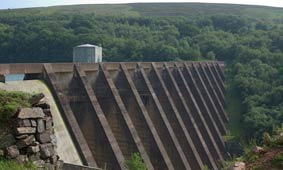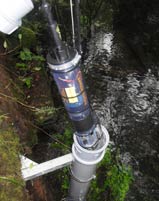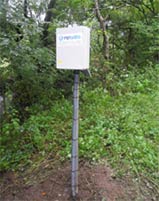Wimbleball Leakage Reduction Programme & Pollution Alarm System
Background
 Wimbleball Dam is located in the county of Somerset and is jointly owned by South West Water Ltd and Wessex Water Ltd and was commissioned in 1979. Since commissioning, the dam has leaked via its foundations and works have now been commissioned by the owners to remediate the leakage. These works (the main works) consist of drilling a series of boreholes into the foundation strata beneath the dam and injecting high strength/high penetrability liquid cement grouts to block the natural fissures in the bedrock through which the leakage is flowing. These works are extensive and will involve the entire Southern half of the dam structure and up onto the Southern flank. The dam will not be emptied for the works and will operate as normal. The dam is located in a National Park and there are public rights of way that run through the proposed working areas and access to the dam itself is needed for its continuing operation.
Wimbleball Dam is located in the county of Somerset and is jointly owned by South West Water Ltd and Wessex Water Ltd and was commissioned in 1979. Since commissioning, the dam has leaked via its foundations and works have now been commissioned by the owners to remediate the leakage. These works (the main works) consist of drilling a series of boreholes into the foundation strata beneath the dam and injecting high strength/high penetrability liquid cement grouts to block the natural fissures in the bedrock through which the leakage is flowing. These works are extensive and will involve the entire Southern half of the dam structure and up onto the Southern flank. The dam will not be emptied for the works and will operate as normal. The dam is located in a National Park and there are public rights of way that run through the proposed working areas and access to the dam itself is needed for its continuing operation.
It is expected that the leakage flows and other associated flows will become contaminated with drill flushings during drilling and cement from the grouts during their injection and these contaminated flows must be treated, as they eventually join the downstream water release flows from the dam. Means must be provided to conduct these contaminated flows and all liquid arisings from the works to treatment plants
It is from the baseline readings provided from RS Hydro that it will be possible to commission the water treatment plants to return the treated water to the watercourse in way that will disturb the existing water course adversely.
Environmental Impact
The potential environmental impact of pumping grout into the base of the dam on the reservoir water and its licensed compensation flows cannot be over exaggerated and through continued communications with the associated regulatory bodies associated with this project namely the Environment Agency, the South West Lakes Trust and the clients themselves a deliverable solution was agreed. As such it is critical that there is an automated alarm system if such a scenario happened. Apart from obvious visual pollution control and monitoring, the most definitive way of monitoring is to deploy sufficient water quality monitoring equipment in the river to ensure that there is no release of sediment or grout. RS Hydro were contracted to provide a real-time early warning system to protect the river and its wildlife from any pollution. To make things more complicated there is no power, telephone lines or GSM signal for the river catchment immediately downstream of the dam. It is extremely important that any installation is not visually intrusive considering its location. RS Hydro also do not need to use satellite modem technology which is expensive and also power-hungry. RS Hydro were the only company to be able to provide a proven environmental monitoring solution.
The Solution
The exact location of the leakage is not known. As such the Clients designers have selected from the available geological / geo-physical information the position of the new injection points. The drilling and grouting operation will be carried out using a system called descending stage grouting, this is an operation that requires the drilling to be carried out to an agreed depth (typically five metres) and then injecting the grout mixture. The idea is that the drilling equipment will always be drilling the minimum amount of virgin strata at any given time. The decrease in the permeability of the rock will be checked and controlled by a rigorous water testing regime. The very nature that over 1000 stages of grouting will be taking place means that the contractor requires a robust and intelligent solution to getting real-time warnings should the grouting operations affect the natural make up of the existing water courses. A veil of grout injection points will act to create a permanent barrier or grout curtain upstream to augment the existing grout curtain arrangement . However, due to the apparent presence of a number of springs further downstream on the southern flank, environmental monitoring of the compensation flow, the river and the springs are all required as they could all be a source of pollution if the grout is allowed to percolate. To complicate matters further, there is an established fish farm less than 0.5km downstream of the dam itself.
RS Hydro have created a complex real-time water quality monitoring network to provide an instantaneous alarm via SMS, email, voicemail and audible siren* (*once the construction phase commences) to ensure that work is stopped immediately should grout leak into the river. The system comprises of 5 no Manta2 multiparameter water quality sondes measuring optical dissolved oxygen, electrical conductivity, pH, REDOX/ORP, turbidity and depth. All of the sondes are attached to small radio telemetry units which upload data as often as required but typically every 15-minutes 24/7. Apart from the water quality sondes, the wireless telemetry units are very small and are powered by very small solar panels (A5-size!!!). This allows for the system to be very discrete and visually unobtrusive. The valley downstream of the dam is not only very incised but also meanders which mean that the furthermost downstream sensors cannot see the dam directly. As such a small self-powered relay station, no bigger than a pencil case has been installed between the downstream stations and the upstream stations.
 As there is no phone signal near the dam, a small GPRS-UHF base station has been installed at a higher elevation about 1km from the dam itself. The radio modem of this base station can then communicate with the local radio telemetry units. Any or all of the monitoring point radio telemetry units can also act as a relay to communicate with any other station. As such it is possible to build a very strong radio network. Unlike GPRS/GSM telemetry units, the addWAVE A753 radio telemetry units use much less power and can afford to stay on all day long. As such it is possible to communicate with any of the radios and attached instrumentation at any time. Furthermore, it is also possible for any one monitoring point to control any switched instrumentation on any other or all of the other monitoring stations. For example, if one station went into alarm it could activate flashing lights at all of the other stations more or less instantaneously once an alarm threshold has been exceeded.
As there is no phone signal near the dam, a small GPRS-UHF base station has been installed at a higher elevation about 1km from the dam itself. The radio modem of this base station can then communicate with the local radio telemetry units. Any or all of the monitoring point radio telemetry units can also act as a relay to communicate with any other station. As such it is possible to build a very strong radio network. Unlike GPRS/GSM telemetry units, the addWAVE A753 radio telemetry units use much less power and can afford to stay on all day long. As such it is possible to communicate with any of the radios and attached instrumentation at any time. Furthermore, it is also possible for any one monitoring point to control any switched instrumentation on any other or all of the other monitoring stations. For example, if one station went into alarm it could activate flashing lights at all of the other stations more or less instantaneously once an alarm threshold has been exceeded.
The alarm setup includes emails, SMS and voicemail messages to personnel at site and also at HQ to ensure that any potential pollution event is contained immediately. Users are able to login anywhere where there is an internet connection via a mobile device or PC. In this case all of the water quality instrumentation will be installed for at least 6-9 months prior to any works commencing to establish baseline data. With the known characteristics of the grout to be used, it is possible to create an algorithm-based alarm using all of the parameters. By way of example, it is possible to activate an alarm where a dissolved oxygen level falls below a specified percentage or by rate and at the same time electrical conductivity rises in the same period. Other parameters such as turbidity and pH would also rise given a pollution event. Some of the multiparameter sondes are almost 1km downstream and any pollution event would be highly diluted. As such, the sondes have to be highly accurate and provide high resolution and repeatability.
The Wider Picture
 In times gone by we were all happy to capture data to understand the physical, chemical and biological processes in our environment but as man engineers his environments to suit himself, the environments that we create either by design or by natural processes, must be modified in the least destructive manner that we can achieve. This will require more sophisticated monitoring methodologies and technologies to ensure that an appropriate pool of information is maintained and updated as our knowledge-base grows. In scenarios such as this, it is no good to know that a pollution event occurred 6 hours ago or a few days ago; we need to prevent it and as such wireless telemetry systems and multi-parameter sondes are a good frontline defence for ensuring that pollution events are prevented. The Adcon telemetry system by RS Hydro can be used in any similar scenario, anywhere in the world. New sensor technologies are providing more and more opportunities to better understand and control the impacts on our environment. For more information on this project and others please contact us.
In times gone by we were all happy to capture data to understand the physical, chemical and biological processes in our environment but as man engineers his environments to suit himself, the environments that we create either by design or by natural processes, must be modified in the least destructive manner that we can achieve. This will require more sophisticated monitoring methodologies and technologies to ensure that an appropriate pool of information is maintained and updated as our knowledge-base grows. In scenarios such as this, it is no good to know that a pollution event occurred 6 hours ago or a few days ago; we need to prevent it and as such wireless telemetry systems and multi-parameter sondes are a good frontline defence for ensuring that pollution events are prevented. The Adcon telemetry system by RS Hydro can be used in any similar scenario, anywhere in the world. New sensor technologies are providing more and more opportunities to better understand and control the impacts on our environment. For more information on this project and others please contact us.
